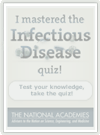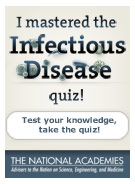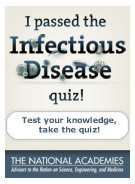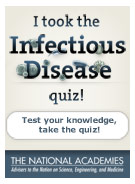
What You Need To Know About Infectious Disease
What do you know about infectious disease?
Which of the following global events does NOT have an impact on the spread of infectious disease:
-
Sorry, that’s incorrect.
The expanded use of cell phones does not have an impact on the spread of infectious disease. Climate change, ecosystem disturbances, war, poverty, migration, and global trade all contribute to the spread of infectious disease.
-
Correct!
The expanded use of cell phones does not have an impact on the spread of infectious disease. Climate change, ecosystem disturbances, war, poverty, migration, and global trade all contribute to the spread of infectious disease.
-
Sorry, that’s incorrect.
The expanded use of cell phones does not have an impact on the spread of infectious disease. Climate change, ecosystem disturbances, war, poverty, migration, and global trade all contribute to the spread of infectious disease.
-
Sorry, that’s incorrect.
The expanded use of cell phones does not have an impact on the spread of infectious disease. Climate change, ecosystem disturbances, war, poverty, migration, and global trade all contribute to the spread of infectious disease.
How many people in the world do not have access to an adequate water supply?
-
Sorry, that’s incorrect.
Worldwide, 884 million people do not have access to an adequate water supply, and about three times that number lack basic sanitation services. An estimated 2 million deaths a year can be attributed to unsafe water supplies.
-
Sorry, that’s incorrect.
Worldwide, 884 million people do not have access to an adequate water supply, and about three times that number lack basic sanitation services. An estimated 2 million deaths a year can be attributed to unsafe water supplies.
-
Correct!
Worldwide, 884 million people do not have access to an adequate water supply, and about three times that number lack basic sanitation services. An estimated 2 million deaths a year can be attributed to unsafe water supplies.
Which are larger?
-
Correct!
Bacteria are 10 to 100 times larger than viruses.
-
Sorry, that’s incorrect.
Bacteria are 10 to 100 times larger than viruses.
Which of the following is needed to help improve the public health situation in developing countries?
- More safe water supplies
- Better sewage treatment and disposal
- Improved food safety and vaccination programs
- All of the above
-
Sorry, that’s incorrect.
All of the above are urgently needed in developing nations. A major barrier to achieving these improvements is the underlying weakness of health systems in resource-poor countries, including a shortage of health workers and a lack of disease surveillance programs.
-
Sorry, that’s incorrect.
All of the above are urgently needed in developing nations. A major barrier to achieving these improvements is the underlying weakness of health systems in resource-poor countries, including a shortage of health workers and a lack of disease surveillance programs.
-
Sorry, that’s incorrect.
All of the above are urgently needed in developing nations. A major barrier to achieving these improvements is the underlying weakness of health systems in resource-poor countries, including a shortage of health workers and a lack of disease surveillance programs.
-
Correct!
All of the above are urgently needed in developing nations. A major barrier to achieving these improvements is the underlying weakness of health systems in resource-poor countries, including a shortage of health workers and a lack of disease surveillance programs.
Public health officials can identify the outbreak of disease by monitoring certain patterns of behavior through syndromic surveillance. Which of the following is one of the signs used to identify a disease outbreak using this system?
- Level of school and work absenteeism
- Sales of over-the-counter medication
- Number of illness-related 911 calls
- All of the above
-
Sorry, that’s incorrect.
In syndromic surveillance, all of the above are used in addition to other patterns that suggest an outbreak. Despite the emergence of this innovative surveillance method, most surveillance still depends on tracking reported infections.
-
Sorry, that’s incorrect.
In syndromic surveillance, all of the above are used in addition to other patterns that suggest an outbreak. Despite the emergence of this innovative surveillance method, most surveillance still depends on tracking reported infections.
-
Sorry, that’s incorrect.
In syndromic surveillance, all of the above are used in addition to other patterns that suggest an outbreak. Despite the emergence of this innovative surveillance method, most surveillance still depends on tracking reported infections.
-
Correct!
In syndromic surveillance, all of the above are used in addition to other patterns that suggest an outbreak. Despite the emergence of this innovative surveillance method, most surveillance still depends on tracking reported infections.
How many people in the United States die from flu-related complications each year?
-
Sorry, that’s incorrect.
About 36,000 people die from flu-related complications each year in the United States. More than 200,000 are hospitalized.
-
Correct!
About 36,000 people die from flu-related complications each year in the United States. More than 200,000 are hospitalized.
-
Sorry, that’s incorrect.
About 36,000 people die from flu-related complications each year in the United States. More than 200,000 are hospitalized.
True or False: Most infectious diseases are not impacted by changes in the environment.
-
Sorry, that’s incorrect.
Most infectious diseases are impacted by changes in the environment. Malaria, dengue, and viral encephalitis infections, for example, are highly sensitive to environmental changes.
-
Correct!
Most infectious diseases are impacted by changes in the environment. Malaria, dengue, and viral encephalitis infections, for example, are highly sensitive to environmental changes.
Each year, how many Americans become infected by what they eat?
-
Sorry, that’s incorrect.
Each year about 76 million Americans—or one in four—become infected by what they eat. Approximately 325,000 are hospitalized. More than 5,000 (14 a day) die.
-
Sorry, that’s incorrect.
Each year about 76 million Americans—or one in four—become infected by what they eat. Approximately 325,000 are hospitalized. More than 5,000 (14 a day) die.
-
Correct!
Each year about 76 million Americans—or one in four—become infected by what they eat. Approximately 325,000 are hospitalized. More than 5,000 (14 a day) die.
Which of the following is not a viral disease:
-
Sorry, that’s incorrect.
Trichinosis is not a viral disease. It is caused by a helminth (parasitic worm) found in undercooked meat, not by a virus.
-
Sorry, that’s incorrect.
Trichinosis is not a viral disease. It is caused by a helminth (parasitic worm) found in undercooked meat, not by a virus.
-
Correct!
Trichinosis is not a viral disease. It is caused by a helminth (parasitic worm) found in undercooked meat, not by a virus.
Thank you for taking our quiz.
Place this badge on your Facebook page to show your friends what you know about infectious disease.
Place this badge on your Facebook page to show your friends what you know about infectious disease.
OR, get a higher score to unlock a different badge.

Place this badge on your Facebook page to show your friends what you know about infectious disease.
OR, get a higher score to unlock a different badge.

Explore Other Topics
Disease Watchlist
Infectious Disease Defined
- Symptom
A subjective indication of the presence of disease or a departure from the body’s normal state of functioning.


